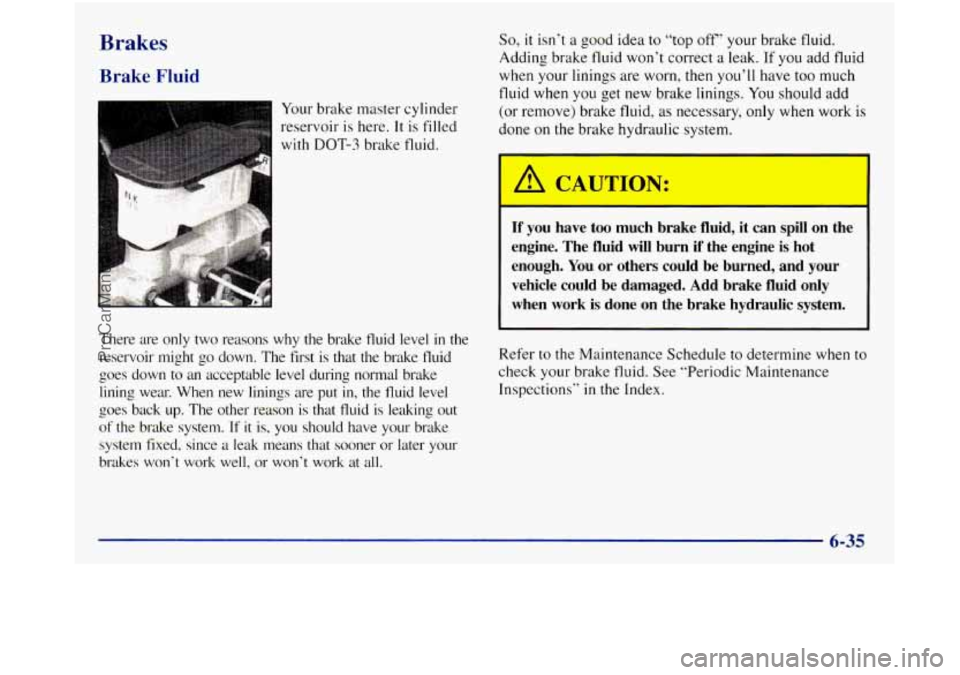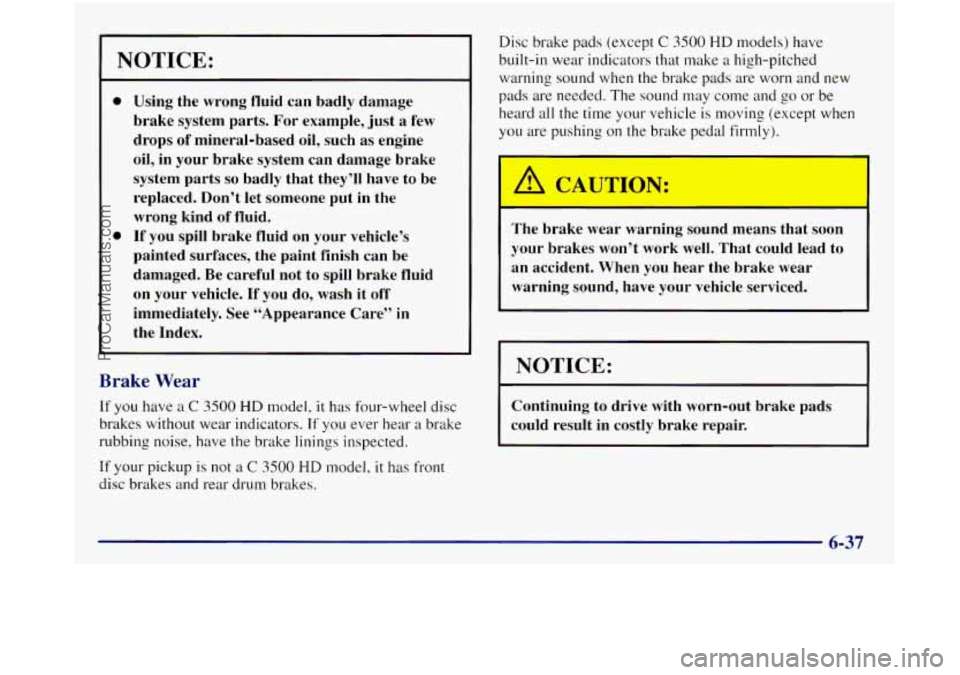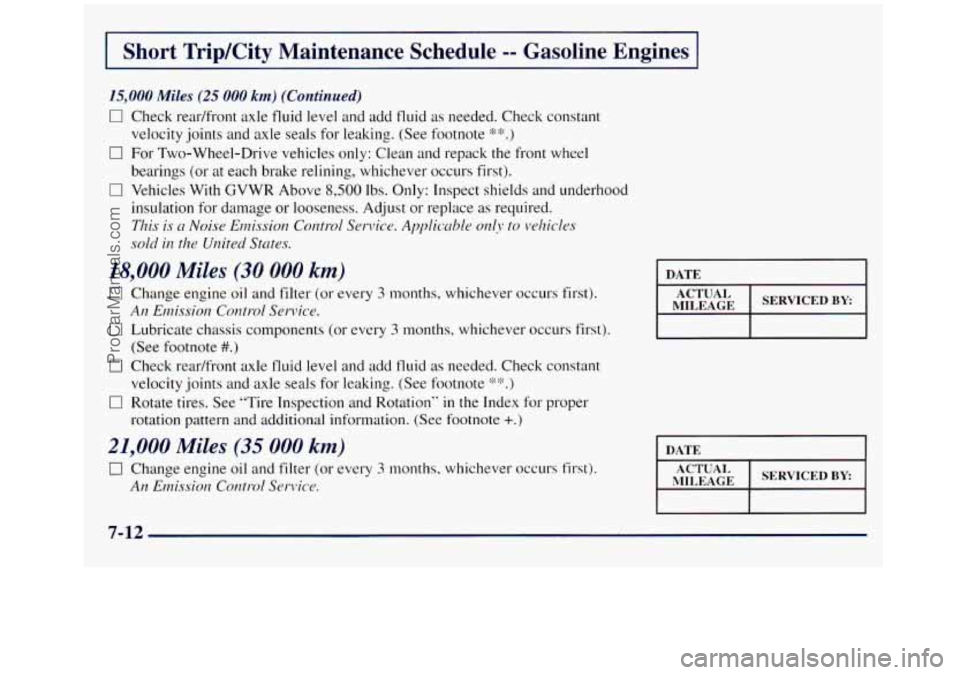Page 301 of 452
“VORTEC” 4300,5000,5700 Engine, “VORTEC” 5700 engine shown, locations for other engines similar.
When you lift
up the hood you’ll see:
A. Battery
G. Automatic Transmission L. Clutch Fluid Reservoir
B. Air Cleaner
Dipstick
(If Equipped) (If Equipped)
C. Radiator Cap H. Fan M. Windshield Washer Fluid
D. Coolant Recovery Tank I. Power Steering Fluid Reservoir Reservoir
E. Air Filter Restriction Indicator J. Engine Oil Fill N. FuseRelay Center
F. Engine Oil Dipstick K. Brake Fluid Reservoir
6-11
ProCarManuals.com
Page 302 of 452
“VORTEC” 7400 Engine
A. Battery
B. Coolant Recovery Tank
C. Air Cleaner
D. Radiator Cap
E. Air Filter Restriction Indicator
F. Engine Oil Dipstick
G. Automatic Transmission L. Clutch Fluid Reservoir
Dipstick (If Equipped)
(If Equipped)
H. Engine Oil Fill M. Windshield Washer
I. Fan Fluid Reservoir
J. Power Steering Fluid Reservoir N. Fusemelay Center
K. Brake Fluid Reservoir
ProCarManuals.com
Page 312 of 452

Checking Transmission Fluid Hot
Get the vehicle warmed up by driving about 15 miles
(24 km) when outside temperatures are above 50°F
(10°C). If it's colder than
50°F (IOOC), drive the
vehicle in THIRD
(3) until the engine temperature gage
moves and then remains steady for 10 minutes. Then
follow
the hot check procedures.
Checking Transmission Fluid Cold
A cold check is made after the vehicle has been sitting
for eight hours or more with the engine off and is used
only as a reference. Let the engine run at idle for five
minutes if outside temperatures are 50°F (10°C) or
more.
If it's colder than 50°F ( 1 O"C), you may have
to idle the engine longer. Should the fluid level be low
during
a cold check, you must perform a hot check
before adding fluid. This will give you
a more accurate
reading of the fluid level.
Checking the Fluid Hot or Cold
Park your vehicle on a level place. Keep the
engine running.
With the parking brake applied, place the shift lever
in PARK (P).
With your foot on the brake pedal, move the shift
lever through each gear range, pausing for about three seconds
in each range.
Then, position the shift
lever
in PARK (P).
Let the engine run at idle for three minutes or more.
Then, without shutting
off the engine, follow these steps:
1. The red transmission dipstick handle is located at the
rear
of the engine compartment, on the passenger's
side. Flip the handle up and then
pull out the dipstick
and wipe
it with a clean rag or paper towel.
then pull it back out again.
2. Push it back in all the way, wait three seconds and
6-22
ProCarManuals.com
Page 325 of 452

Brakes
Brake Fluid
Your brake master cylinder
reservoir is here. It
is filled
with DOT-3 brake fluid.
There are only two reasons why the brake fluid level
in the
reservoir might go down. The first is that the brake fluid
goes down to an acceptable level during normal brake
lining wear. When new linings are put
in, the fluid level
goes back up. The other reason is that fluid
is leaking out
of the brake system. If it is, you should have your brake
system fixed, since
a leak means that sooner or later your
brakes won’t work well, or won’t work at
all.
So, it isn’t a good idea to “top off’ your brake fluid.
Adding brake fluid won’t correct a leak.
If you add fluid
when your linings are worn, then you’ll
have too much
fluid when
you get new brake linings. You should add
(or remove) brake fluid,
as necessary, only when work is
done
on the brake hydraulic system.
- - -
4 CAU-ION:
If you have too much brake fluid, it can spill on the
engine. The fluid
will burn if the engine is hot
enough. You or others could be burned, and your
vehicle could be damaged. Add brake fluid only when
work is done on the brake hydraulic system.
Refer to the Maintenance Schedule to determine when to
check your brake fluid. See “Periodic Maintenance
Inspections” in the Index.
6-35
ProCarManuals.com
Page 326 of 452
Checking Brake Fluid
You can check the brake fluid without taking off the cap.
Just look at the brake fluid reservoir. The fluid level
should be above
MIN. If it isn’t, have your brake system
checked to see if there is a leak.
After work
is done on the brake hydraulic system,
make sure the level is above the
MIN but not over the
MAX mark or the top
of the window on the side of
the reservoir. fluid
-- such
as Delco Supreme llw (GM Part
No. 12377967). Use new brake fluid from a sealed
container only.
Always clean the brake fluid reservoir cap and the area
around the cap before removing it. This will help keep
dirt from entering the reservoir.
A CAUTION:
I
With the wrong kind of fluid in your brake
system,
your brakes may not work well, or they
may not even work at all. This could cause a
crash. Always use the proper brake fluid.
I I
6-36
ProCarManuals.com
Page 327 of 452

NOTICE:
0
0
Using the wrong fluid can badly damage
brake system parts. For example, just a few
drops of mineral-based oil, such as engine
oil, in your brake system can damage brake
system parts
so badly that they’ll have to be
replaced. Don’t let someone put in the
wrong kind of fluid.
If you spill brake fluid on your vehicle’s
painted surfaces, the paint finish can be
damaged.
Be careful not to spill brake fluid
on your vehicle. If you do, wash it
off
immediately. See “Appearance Care” in
the Index.
Brake Wear
If you have a C 3500 HD model, it has four-wheel disc
brakes without wear indicators. If you ever hear
a brake
rubbing noise, have the brake linings inspected.
If your pickup is not a
C 3500 HD model, it has front
disc brakes and rear drum brakes. Disc brake pads
(except
C 3500 HD models) have
built-in wear indicators that make a high-pitched
warning sound when the brake pads are worn and new
pads
are needed. The sound may come and go or be
heard
all the time your vehicle is moving (except when
you are pushing
on the brake pedal firmly).
I
The brake wear warning sound means that soon
your brakes won’t work well. That could lead to
an accident. When you hear the brake wear
warning sound, have your vehicle serviced.
I NOTICE:
Continuing to drive with worn-out brake pads
could result in costly brake repair.
6-37
ProCarManuals.com
Page 364 of 452
Fuse/Circuit Breaker Usage
20
21
22
23
24
A
B
PRNDL, Automatic Transmission,
Speedometer, Check Gages
Warning Light
Security/Steering
Not Used
Not Used
Front Axle,
4WD Indicator Lamp,
TP2 Relay (Gasoline Engine)
Power Door Lock, Six-Way Power Seat, Keyless Entry Module
Power Windows
Underhood Fuse/Relay Center
The underhood fusehelay center is located in the rear of
the engine compartment near the brake fluid reservoir.
Move the retainer clips
for the cover to access the
fuse block.
You can remove fuses with a fuse extractor. The fuse
extractor
is mounted to the interior fuse block. TO
remove fuses
if you don’t have a fuse extractor, hold the
end of the fuse between your thumb and index finger
and pull straight out.
6-74
ProCarManuals.com
Page 382 of 452

I Short Trip/City Maintenance Schedule -- Gasoline Engines I
15,000 Miles (25 000 km) (Continued)
0 Check rear/front axle fluid level and add fluid as needed. Check constant
0 For Two-Wheel-Drive vehicles only: Clean and repack the front wheel
0 Vehicles With GVWR Above 8,500 lbs. Only: Inspect shields and underhood
velocity
joints and axle seals for leaking. (See footnote
**.)
bearings (or at each brake relining, whichever occurs first).
insulation for darnage or looseness. Adjust or replace as required.
This is cl Noise Emission Cmztrol Service. Applicable ody fo vei~icles
sold in the United States.
18,000 Miles (30 000 km)
0 Change engine oil and filter (or every 3 months, whichever occurs first).
0 Lubricate chassis components (or every 3 months, whichever occurs first).
0 Check rear/front axle fluid level and add fluid as needed. Check constant
0 Rotate tires. See “Tire Inspection and Rotation’? in the Index for proper
An Emissiorl Control Service.
(See footnote #.)
velocity joints and axle seals for leaking. (See footnote ‘i”i’.)
rotation pattern and additional information. (See footnote +.)
21,000 Miles (35 000 km)
I DATE I
MILEAGE
DATE
0 Change engine oil and filter (or every 3 months, whichever occurs first).
An Emission Cmtrol Service. MI1,EAGE SERVICED BY
7-12
ProCarManuals.com